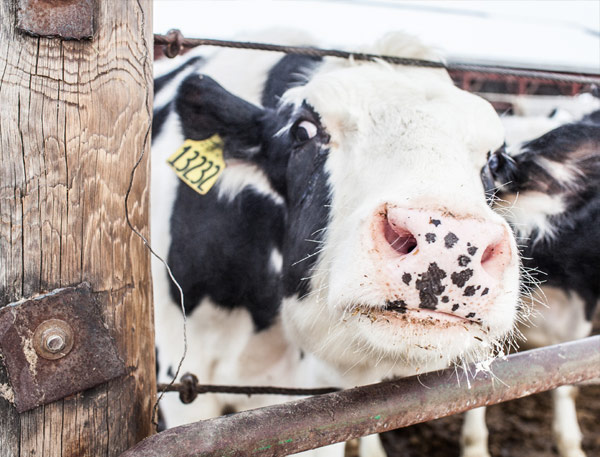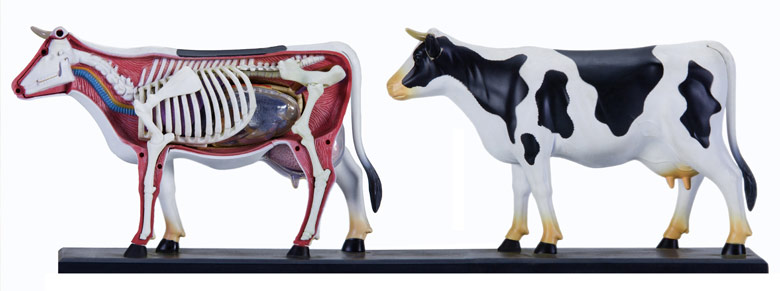You find a cow that calved last night lying down with her head back over her flank. She can’t stand and her ears are cold. She has milk fever! If you treat her before muscle or nerve damage has occurred, an I.V. injection of calcium will get her on her feet in minutes. Unfortunately, she is still in trouble. That bout of severe hypocalcemia sets her up for more problems and makes her more likely to be culled.
But milk fever is just the tip of the iceberg. Sub-clinical hypocalcemia, a calcium deficiency mild enough that cows don’t show any symptoms, is way more prevalent than the clinical form. This is where the big economic drain occurs, with increased incidences of retained placenta, displaced abomasum, ketosis, mastitis, and reduced milk production in early lactation. In many herds, 30–60% of the cows and 25% of the first-calf heifers develop sub-clinical hypocalcemia. At the onset of lactation, large amounts of calcium move from the blood into colostrum and milk. The calcium lost to milk must be replaced from diet calcium or from calcium stored in bones if the cow is to avoid a further decline in blood calcium.
Preventing sub-clinical hypocalcemia will improve the health, productivity, and longevity of cows, as well as improve the economic bottom line of the dairy. And, prevention is possible with SoyChlor®, a palatable chloride supplement for close-up dry dairy cows.
 Many early adopters of the DCAD theory to prevent milk fever had terrible experiences, including me. The chloride and sulfate used in these rations were typically supplied by calcium chloride, calcium sulfate, ammonium chloride, ammonium sulfate, magnesium chloride, and magnesium sulfate salts. They were very unpalatable and producers witnessed a noticeable reduction in feed intake. It was even difficult to get the cows to eat enough anionic salts to become properly acidified. I developed SoyChlor® to solve these problems.
Many early adopters of the DCAD theory to prevent milk fever had terrible experiences, including me. The chloride and sulfate used in these rations were typically supplied by calcium chloride, calcium sulfate, ammonium chloride, ammonium sulfate, magnesium chloride, and magnesium sulfate salts. They were very unpalatable and producers witnessed a noticeable reduction in feed intake. It was even difficult to get the cows to eat enough anionic salts to become properly acidified. I developed SoyChlor® to solve these problems.
SoyChlor® is made using acidic conditions to actually drive chloride into pores within grain particles so that the chloride taste is masked. The anionic supplement also contains magnesium in a very soluble form to prevent the risk of low blood magnesium interfering with calcium regulation. In addition, SoyChlor® provides the cow with highly soluble calcium, which will be available for absorption once intestinal calcium pumps have been activated after calving.
Urine pH can serve as an important tool when formulating dry cow diets. With typical high-potassium dry cow diets, the blood becomes alkaline. Urine pH will be 8–8.5 as the kidneys remove alkalinity from the blood and put it into the urine. Since high diet potassium is causing the alkalosis, the first step in formulating the diet is to reduce the potassium content by choosing lower-potassium forages. With a low-potassium diet the alkalinity of blood and urine can be reduced, but the pH of urine will generally still be 7.5 or above. To really combat hypocalcemia, the blood and urine must be made slightly acidic. Adding chloride or sulfate anions to the diet can acidify the blood and overcome the alkalinizing effect of diet cations such as potassium and sodium. The goal is to add enough anions to the diet to bring urine pH down to 6.0–6.5.
Adjusting diet DCAD is a worthwhile program. Routine urine pH testing can tell the producer if too little or too much SoyChlor® has been added. In addition, great variability in urine pH suggests the cows are sorting the diet or it may indicate the close-up pen is overly crowded. Cows on a proper DCAD program will produce about 700 pounds more milk in the ensuing lactation and suffer fewer fresh cow disorders, which can reduce cull rates. University studies show time and time again that the payback on a good DCAD program is at least 6:1. Early adopters of DCAD often got burned using traditional anionic salts, but we have learned a lot about how to make DCAD adjustment palatable and effective. SoyChlor® puts that science into practice.
SoyChlor® is just one product in the Dairy Nutrition Plus™ family of quality dairy feed ingredients manufactured by Landus Cooperative™. To learn more about SoyChlor® and related products, visit www.dairynutritionplus.com.
Dr. Jesse Goff’s dry cow close-up diet mineral guidelines:
- Keep diet potassium as low as possible (as close to 1% as possible).
- Pre- and post-calving diet magnesium should be 0.4%, using an available form of Magnesium. SoyChlor® takes care of this in the close-up diet, but a very available magnesium oxide should be utilized in the lactating cow diet.
- Bring diet sodium to 0.10–0.12%. More than this can cause udder edema.
- Keep diet phosphorus below 0.32% and above 0.25% in the close-up ration.
- Calcium should be 0.85–1.10%. SoyChlor® brings some calcium to the ration, but if more calcium is desired, calcium sulfate can be utilized. I do not recommend any limestone be used in close-up cow diets. Fresh cow diets should be at least 1% calcium and limestone is fine for this diet.
- Set diet sulfur to 0.35%. Again calcium sulfate can be used to get to this level.
- Add enough chloride to bring average urine pH between 6 and 6.5. If you follow steps 1–6, you should start by bringing diet chloride to within 0.5% of diet potassium; i.e., if diet potassium is 1.3% then use Soychlor® to bring diet chloride to 0.8%. Feed this for a week and check urine pH. For some herds this will be adequate. For many herds you will have to add more Soychlor® in 0.25 pound increments until you achieve the desired urine pH.

